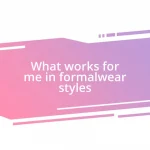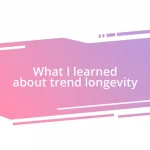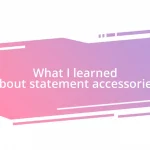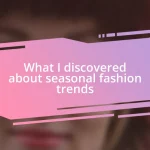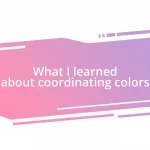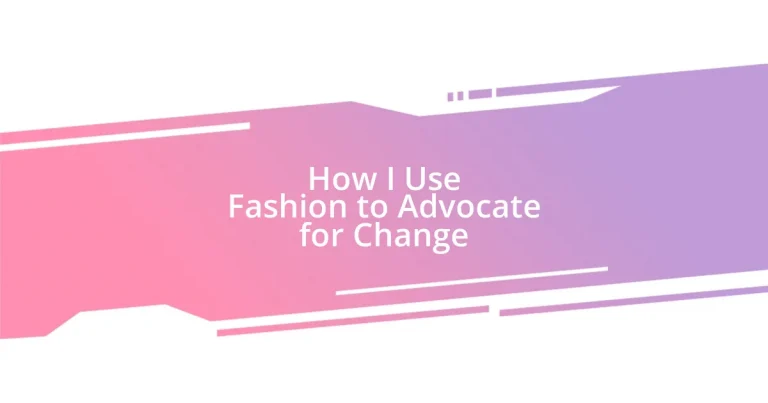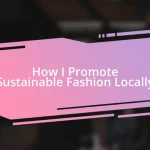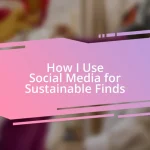Key takeaways:
- Fashion advocacy is a powerful tool for raising awareness and fostering dialogue around social and environmental issues, with personal choices becoming a catalyst for conversations.
- Key issues in fashion advocacy include sustainability, ethical labor, cultural appropriation, body positivity, and the environmental impact of clothing, which require thoughtful consumer engagement.
- Using social media strategically can amplify advocacy efforts, creating a community of like-minded individuals and inspiring collective action towards positive change in the fashion industry.
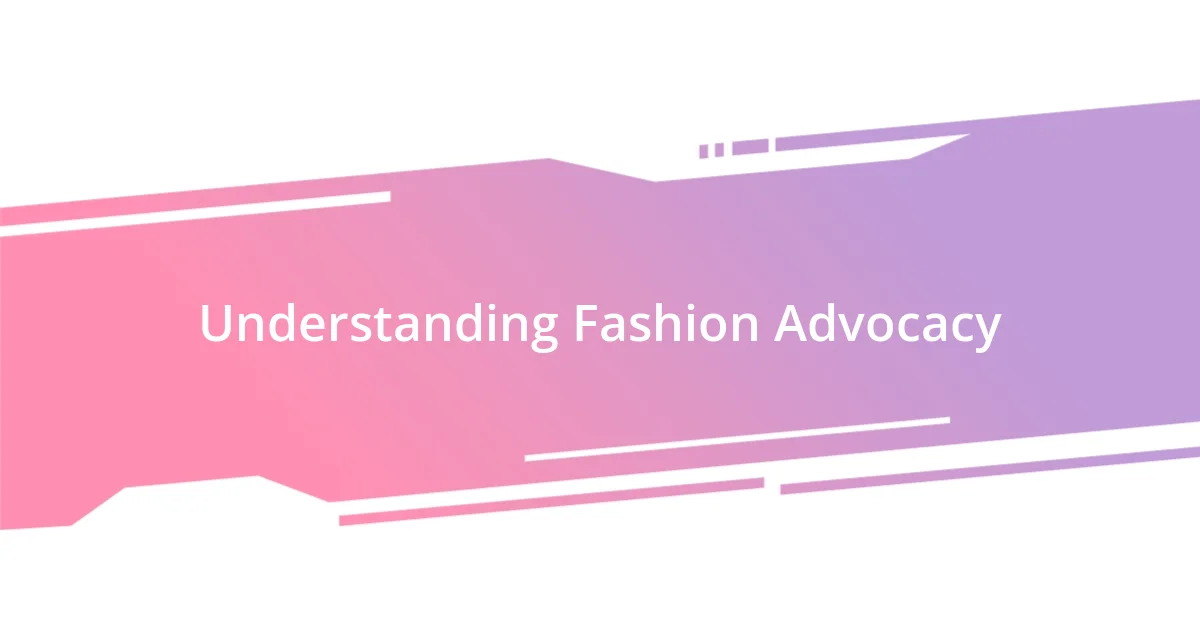
Understanding Fashion Advocacy
Fashion advocacy is more than just wearing trendy clothes; it’s about using style as a powerful tool to raise awareness and promote social change. I remember a time when I wore a t-shirt featuring a bold message about sustainability to a community event. It sparked conversations that opened eyes, and I realized how clothing can be a catalyst for dialogue and understanding.
When I think about fashion advocacy, I often reflect on the emotions tied to our wardrobes. What story does your outfit tell? Just last month, I donned a striking dress made from upcycled materials, and I felt a surge of pride knowing that my choice was supporting eco-friendly practices. It reminded me that our fashion choices can resonate deeply and connect us to causes we care about.
I see fashion as a canvas for self-expression and activism. There’s something exhilarating about merging aesthetics with purpose—like when I customized jeans with patches promoting mental health awareness. Those jeans became my conversation starters, making it clear that fashion can indeed shape narratives and influence hearts. Isn’t it incredible how a single piece of clothing can carry such weight?
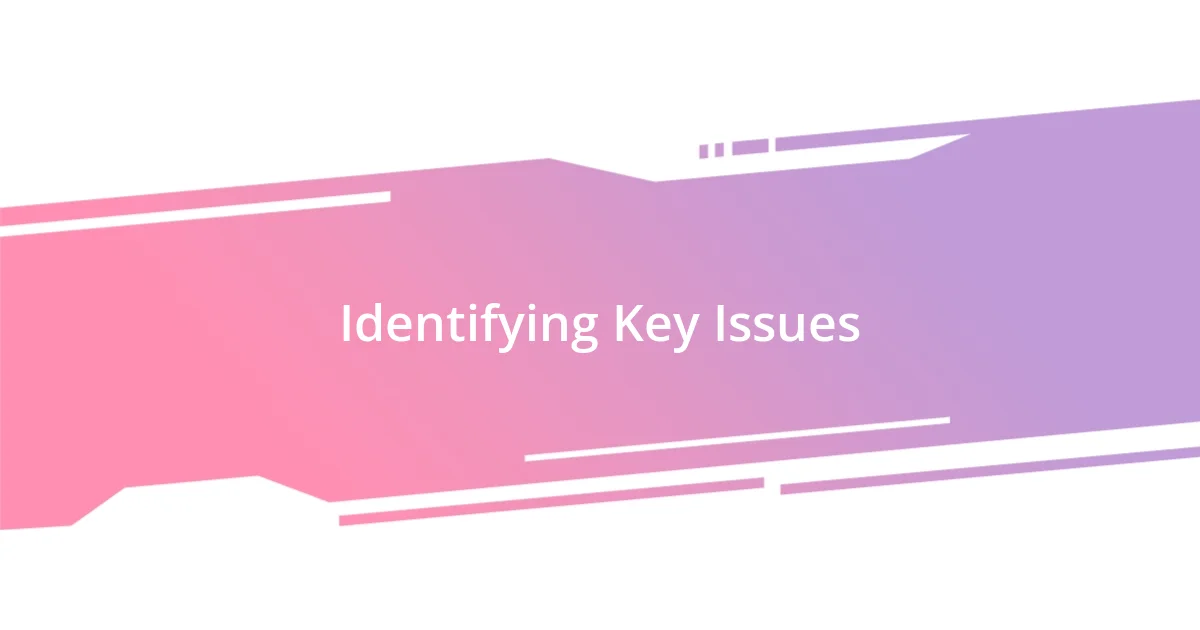
Identifying Key Issues
Identifying key issues can often feel overwhelming, especially with so many social and environmental challenges presenting themselves daily. I remember browsing through my closet one day, realizing that each piece of clothing has a story behind it—some support ethical labor practices, while others have harmful origins. This moment prompted me to think critically about what I wear and how it aligns with my values.
Here are some key issues to consider in fashion advocacy:
- Sustainability: The impact of fast fashion on the environment and the importance of sustainable practices.
- Ethical Labor: Fair wages and working conditions for garment workers globally.
- Cultural Appropriation: Understanding how fashion can respect or exploit cultural expressions.
- Body Positivity: Championing diverse body shapes and sizes in fashion representation.
- Environmental Impact: The effects of textile waste and non-recyclable materials on our planet.
Each of these issues deserves attention and advocacy, reflecting a combination of personal values and broader societal needs. Embracing this awareness allows me to make informed and impactful fashion choices.
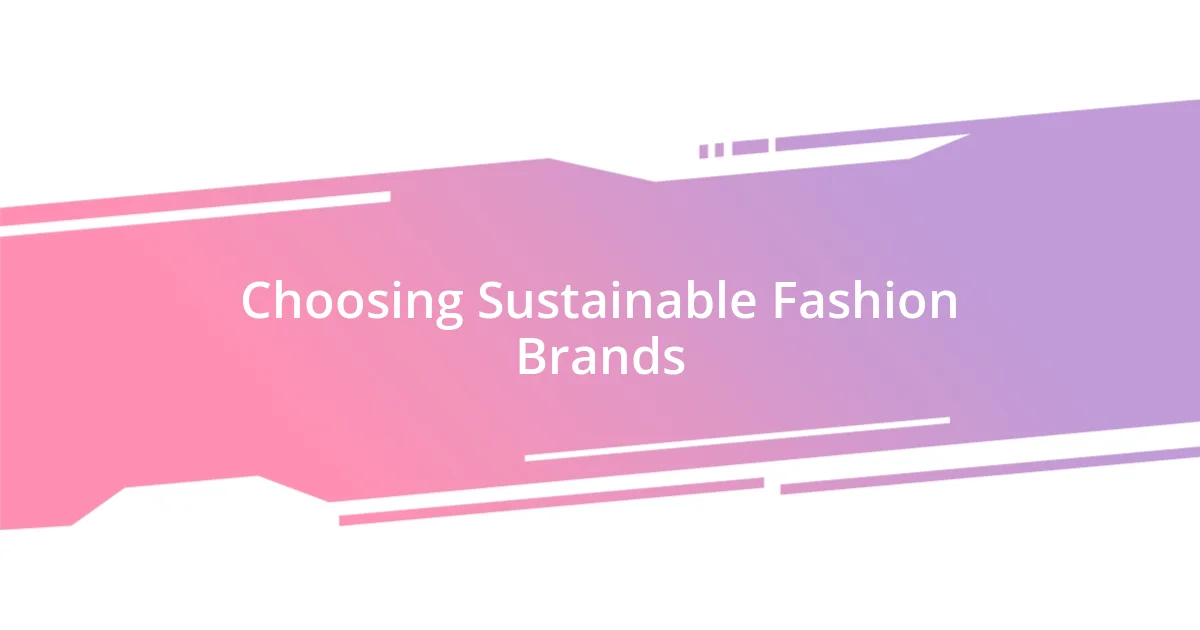
Choosing Sustainable Fashion Brands
Choosing sustainable fashion brands can feel incredibly rewarding. When I decided to shift my shopping habits, I began researching brands that not only look good but also operate ethically. One day, as I sported a chic dress from a sustainable label, a friend complimented me. This led to a heartfelt discussion about the importance of conscious consumerism and the power we hold as shoppers to influence the market.
I often compare sustainable brands to mainstream ones, focusing on their production practices and materials. For instance, while a standard brand might use non-biodegradable fabrics, a sustainable brand prioritizes organic or recycled materials, leaving a lighter environmental footprint. This subtle shift in choice can feel monumental. Each purchase becomes a statement, showcasing that caring for our planet can blend beautifully with style.
When I stumbled upon a local sustainable brand that crafts accessories from reclaimed materials, I was inspired by their commitment to both creativity and conservation. I remember gifting a unique bag from that brand to my sister, who was thrilled not only because of its beauty but also its backstory. It’s these connections—feeling the heart behind the brand and knowing that my choices contribute to positive change—that make me excited about sustainable fashion.
| Criteria | Sustainable Brands | Traditional Brands |
|---|---|---|
| Materials | Organic, recycled, and eco-friendly materials | Non-biodegradable and synthetic fabrics |
| Labor Practices | Fair wages and ethical working conditions | Variable, often unregulated labor practices |
| Environmental Impact | Focus on reducing waste and carbon footprint | Contributes to high levels of waste and pollution |
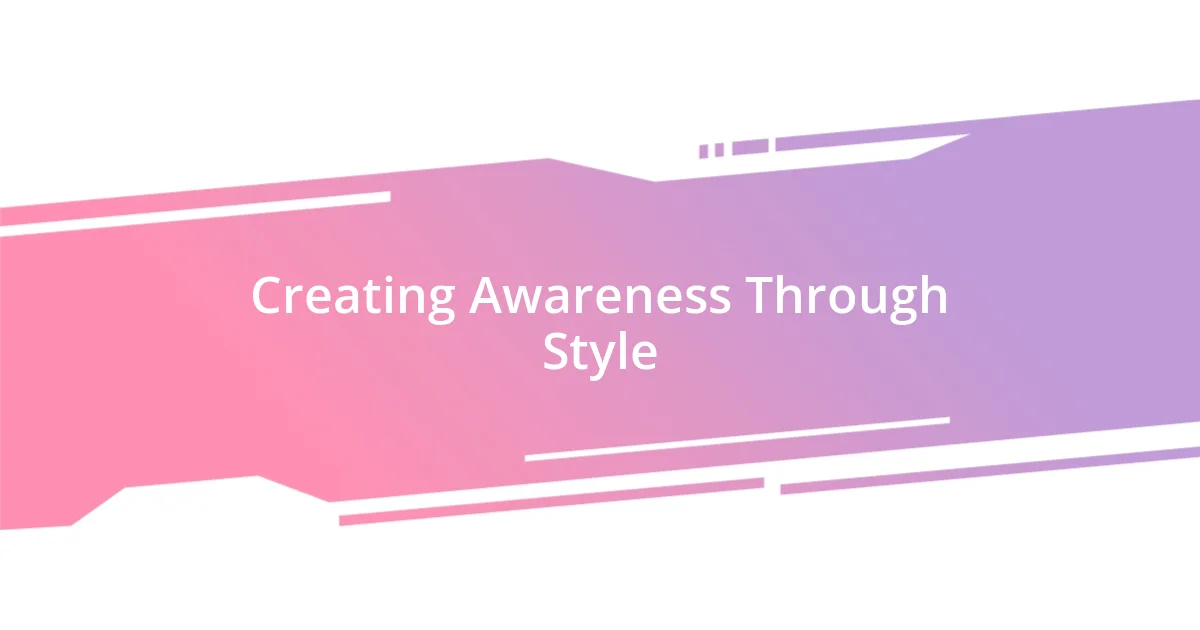
Creating Awareness Through Style
Creating awareness through fashion is an exciting journey that I’ve embraced wholeheartedly. For me, wearing a statement piece often transcends mere aesthetics; it opens the door to conversations about important social issues. I vividly recall rocking a shirt that highlighted mental health awareness at a gathering. It wasn’t just a cool graphic—people were drawn to it, eager to discuss their experiences and thoughts. That moment reinforced how powerful fashion can be as a catalyst for dialogue.
Every time I choose to wear something that aligns with critical issues, I’m making a declaration not only to myself but to those around me. One day, I wore a bold, vibrant scarf that represented the LGBTQ+ community during a local pride event. The reactions were instant and enthusiastic. It felt incredible to be part of a collective celebration while also reminding everyone of the ongoing fight for inclusivity. This simple choice turned my outfit into a voice, creating a ripple effect that encouraged others to express their own stories and support.
I often find myself asking: What message does my outfit convey today? I remember slipping on a pair of eco-friendly shoes made from recycled ocean plastics. Throughout my day, various conversations sprang up about climate change and our individual impacts. It was surprising how a footwear choice could inspire such discussions. Fashion gives us the unique opportunity to not only express ourselves but also to raise awareness about the causes that matter deeply to us. Isn’t that a remarkable way to wear our values with pride?
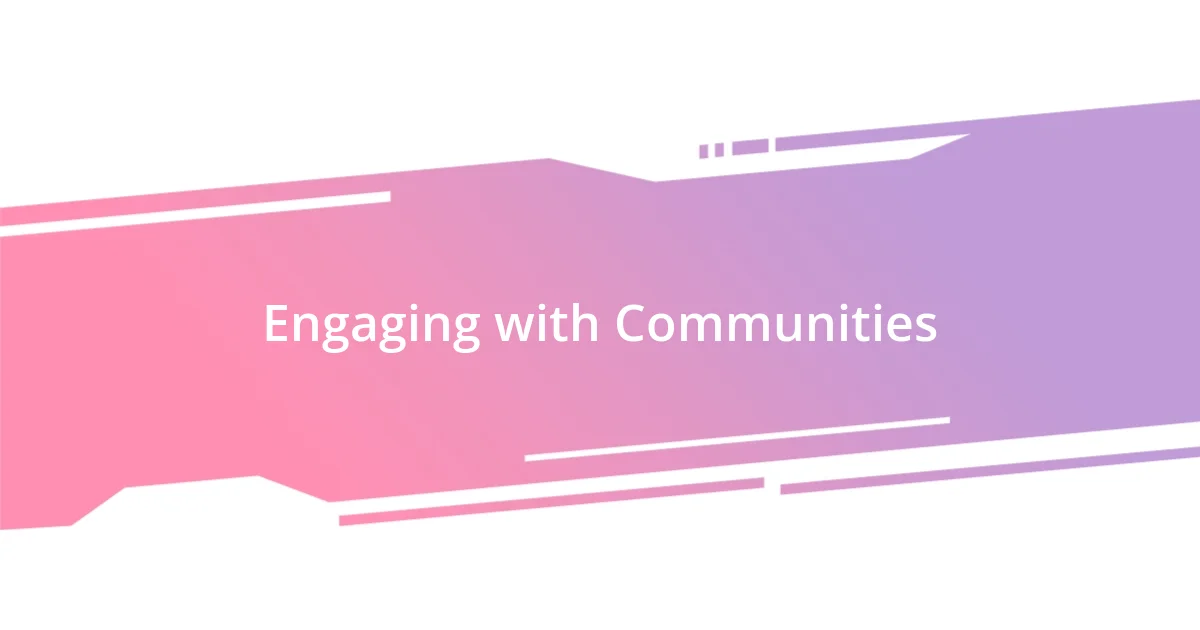
Engaging with Communities
I find that engaging with communities can truly amplify my voice as a fashion advocate. One Saturday, while volunteering at a local shelter, I wore a jacket made from upcycled materials. A few people there noticed it and started asking about the brand, which led us to discuss the importance of supporting sustainable practices. It was incredible to see how fashion could connect us and prompt meaningful conversations about community well-being and environmental challenges.
In another instance, I attended a community event focusing on cultural diversity. I had the chance to wear traditional attire that echoed my heritage, and it was a wonderful experience to see others embracing their own cultures through fashion. This moment reminded me that clothing isn’t just fabric; it’s a medium for storytelling and connection. When we share our heritage through what we wear, we invite understanding and solidarity within our communities.
Every time I participate in local workshops about sustainable fashion, I witness the collective eagerness to learn. I once shared my journey in a workshop, where my story sparked a conversation about embracing individual style while respecting our planet. The excitement in the room was palpable; as others shared their own experiences and ideas, it became clear that we were all part of something larger. Isn’t it amazing how fashion can unite us beyond individual choices and turn our shared values into impactful community action?
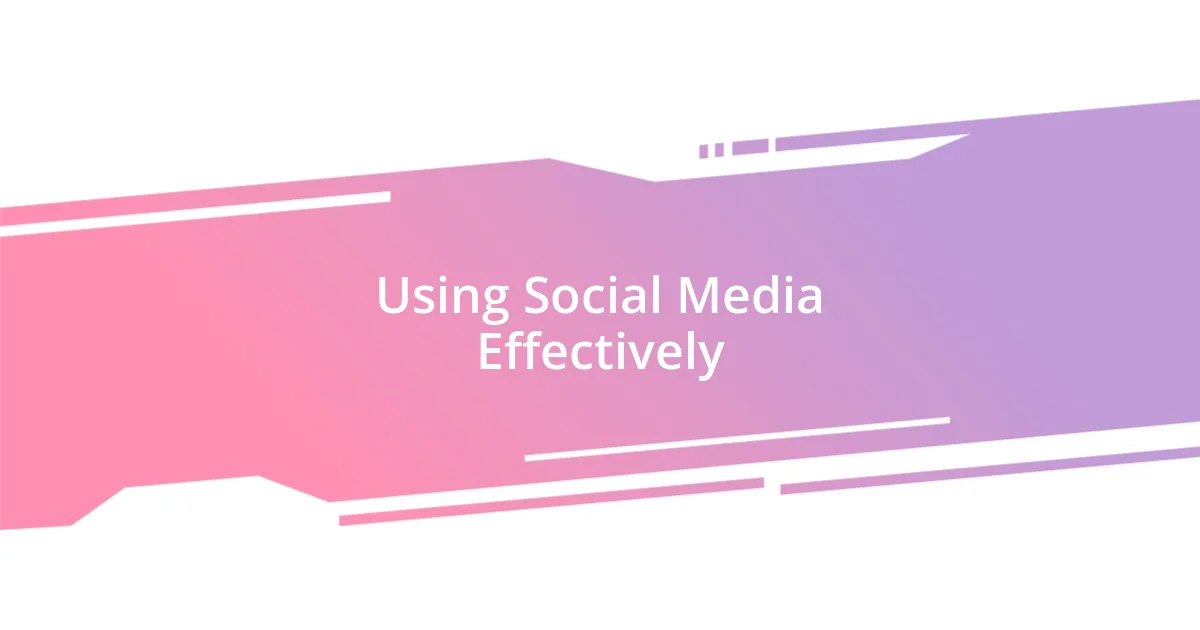
Using Social Media Effectively
Using social media effectively can dramatically enhance my advocacy efforts through fashion. I remember posting a picture of myself wearing a vintage dress that supports body positivity. The comments flooded in with stories of personal journeys and acceptance. It was heartwarming to see how one photo could inspire others to embrace their own unique beauty. Isn’t it fascinating how a simple post can spark a movement of self-love and appreciation in a sea of curated feeds?
I also leverage platforms like Instagram to share the stories behind my outfits. For example, when I wore a t-shirt supporting a local environmental group, I took the time to describe not just the shirt but also the mission behind it. It was incredibly rewarding when followers started asking how they could contribute. This dialogue creates a sense of community, where followers feel motivated not only to engage with my fashion choices but also to take actionable steps toward positive change.
Moreover, using hashtags strategically allows me to connect with like-minded individuals and expand the reach of my message. One time, I used #FashionForChange while showcasing an outfit made from ethically sourced materials. The post caught the attention of several sustainability advocates, leading to collaborations and growing my network further. It’s a reminder that in this digital age, a hashtag can connect us, amplify voices, and create a ripple effect of awareness. How empowering is it to know that each choice and each post can contribute to a larger conversation about change?
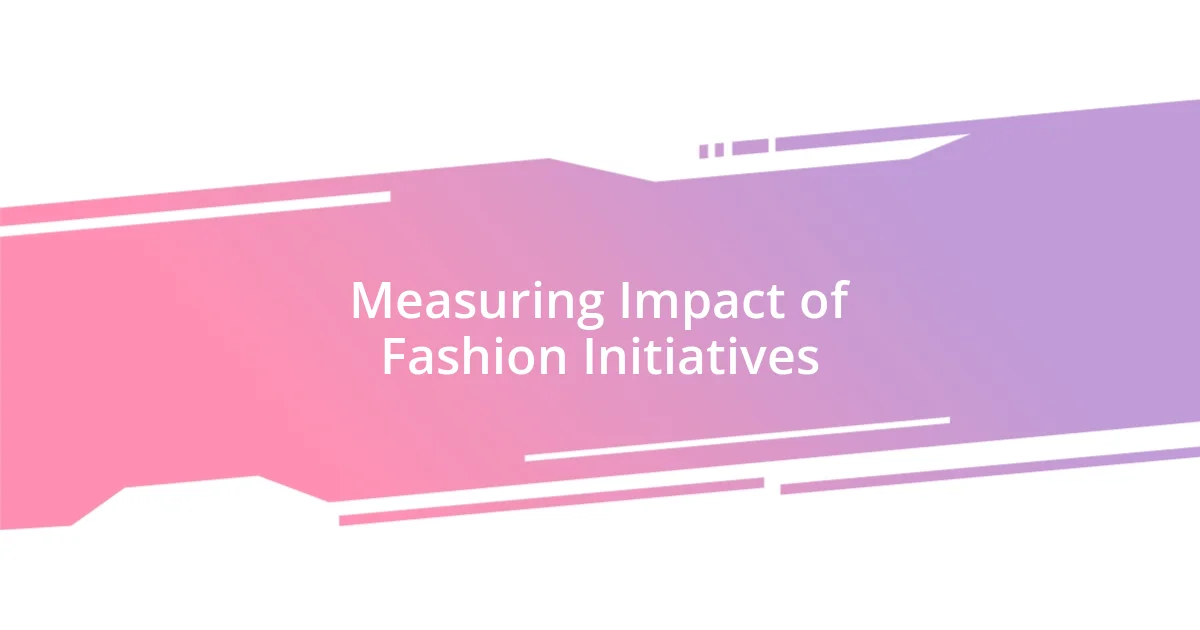
Measuring Impact of Fashion Initiatives
Measuring the impact of fashion initiatives transcends mere statistics; it’s about the stories and shifts in mindset that come from our collective actions. I recall participating in a sustainable fashion event where attendees shared their intentions to switch to eco-friendly brands. Hearing their resolutions made me realize how powerful personal commitment can be in driving change. When individuals recognize their buying power, it feels like each choice they make can resonate like a ripple in a pond.
Another layer to measuring impact lies in the conversations sparked by advocacy. I once organized a small pop-up showcasing local artisans who emphasize sustainable practices. The dialogues sparked discussions on ethics in fashion centered around fair wages and environmental responsibility. Witnessing attendees challenge their preconceived notions was enlightening. Isn’t it incredible how fashion can catalyze people to reconsider their values and choices?
I’ll never forget the sheer excitement on the faces of volunteers during a clothing drive I coordinated. As we sorted donations, conversations flowed about how we could improve recycling in our community. It struck me that initiatives don’t just end with a single event; they create ongoing dialogues. It’s these moments of realization and connection that truly reflect the impact we can have in the fashion space. How do we quantify such intangible changes, and yet, isn’t it clear that the true worth lies in the hearts and minds we influence?


